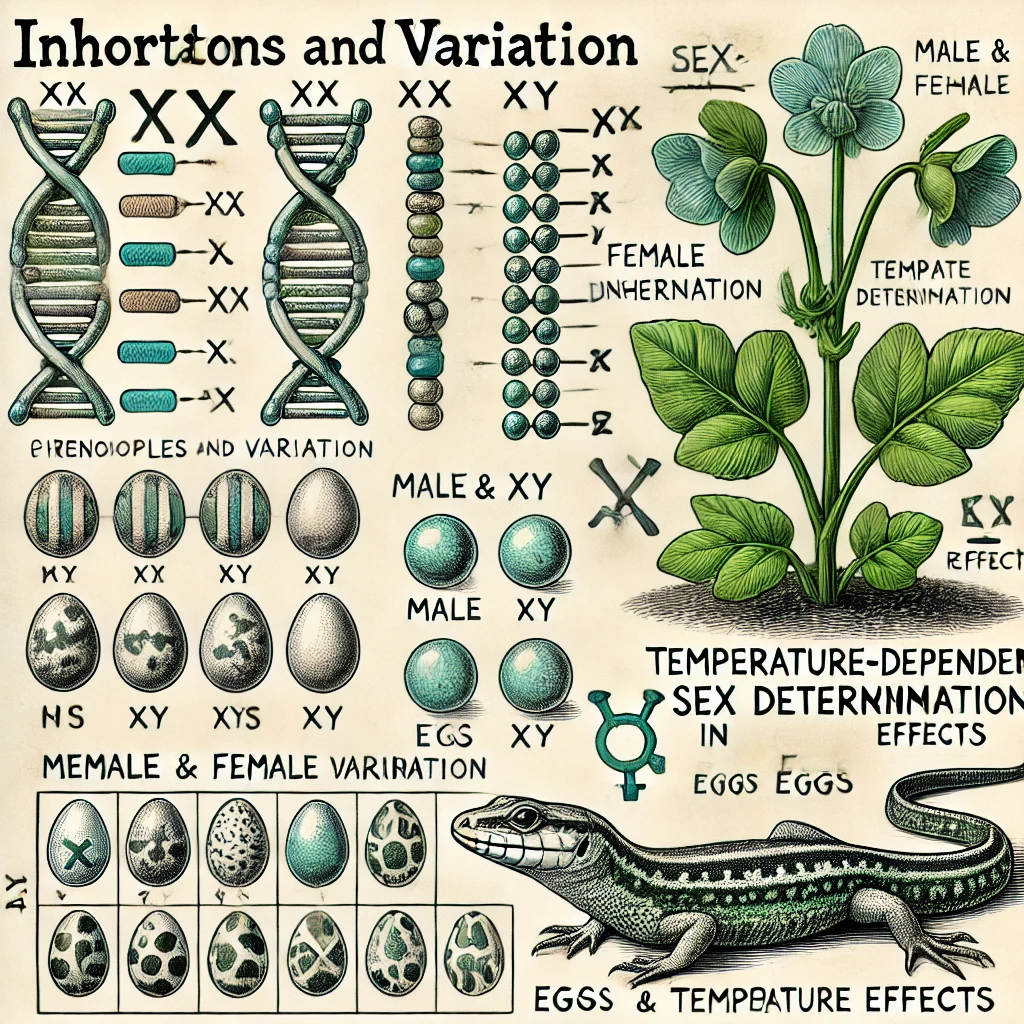The topic of inheritance and variation in biology examines how traits are passed from one generation to the next, exploring the genetic mechanisms that lead to differences within a population. A critical aspect of this is sex determination, the process by which an organism’s sex (male or female) is established. Sex determination mechanisms vary widely among species, involving both genetic and environmental factors.

1. Inheritance and Variation: An Overview
The concept of inheritance refers to the process by which genetic information is passed from parents to offspring. Variation, on the other hand, encompasses the differences in genetic material within and across populations. These principles form the basis of genetics, as initially explored by Gregor Mendel through his experiments on pea plants. Mendel’s laws of inheritance—Law of Segregation, Law of Independent Assortment, and Law of Dominance—are the foundational principles of classical genetics.
- Law of Segregation states that alleles separate during the formation of gametes, and each gamete receives only one allele from each gene pair.
- Law of Independent Assortment describes how alleles of different genes assort independently during gamete formation, leading to varied combinations of traits.
- Law of Dominance dictates that some alleles are dominant and will mask the expression of recessive alleles in heterozygous pairs.
These laws are essential to understanding how genetic variation and inheritance work.
2. Chromosomes and Genes
Chromosomes are structures within cells that contain DNA, the molecule that carries genetic instructions. Humans have 23 pairs of chromosomes, including one pair of sex chromosomes. Genes are specific sequences of DNA that code for proteins and determine various traits. Each gene has different versions, known as alleles, which contribute to variations in physical characteristics, such as eye color or blood type.
- Autosomal Chromosomes vs. Sex Chromosomes: Humans have 22 pairs of autosomal chromosomes and one pair of sex chromosomes, labeled as X and Y. Females typically have two X chromosomes (XX), and males have one X and one Y chromosome (XY).
- Genotype and Phenotype: The genotype is the genetic makeup of an organism, while the phenotype is the observable traits. Different combinations of alleles (genotype) lead to variations in physical appearance (phenotype) among individuals.
3. Sex Determination Mechanisms
Sex determination systems vary significantly among species. The primary systems include:
- XX-XY System: Common in mammals, including humans. Males are XY, and females are XX. The presence of a Y chromosome, specifically the SRY gene (Sex-determining Region Y), triggers male development.
- ZZ-ZW System: Observed in birds, some fish, and reptiles. Here, males are ZZ (homogametic), and females are ZW (heterogametic). The W chromosome determines female sex.
- XX-XO System: Found in insects like grasshoppers. Females are XX, while males have a single X chromosome (XO).
- Environmental Sex Determination: Seen in reptiles like turtles and some fish, where environmental factors, such as temperature, influence sex. For instance, in many reptiles, the temperature of egg incubation determines whether the offspring will be male or female.
4. Human Sex Determination
In humans, sex determination is governed by the presence or absence of the Y chromosome and its specific genes. The process can be broken down into several stages:
- Genetic Determination: The presence of the SRY gene on the Y chromosome initiates the development of male characteristics. Without the SRY gene, the default pathway leads to female development.
- Gonadal Differentiation: Around the sixth week of development, undifferentiated gonads begin to develop. In males, the SRY gene activates other genes that lead to the formation of testes, which then produce testosterone and anti-Müllerian hormone, supporting male differentiation.
- Hormonal Influence: Hormones play a crucial role in sexual differentiation. Testosterone supports the development of male reproductive organs, while the absence of these hormones leads to the development of female reproductive structures.
5. Genetic Disorders of Sex Determination
Genetic mutations can affect sex determination, leading to disorders such as:
- Androgen Insensitivity Syndrome (AIS): In this condition, individuals have an XY chromosome pattern but are resistant to male hormones (androgens), leading to a female physical appearance.
- Klinefelter Syndrome (XXY): Individuals with this condition have an extra X chromosome, leading to physical traits such as reduced body hair and infertility.
- Turner Syndrome (XO): Females with only one X chromosome (XO) often exhibit short stature and lack of ovarian development.
6. Genetic and Environmental Interplay in Sex Determination
Although genetic factors primarily determine sex in humans, environmental factors can influence sex determination in other species. Temperature-dependent sex determination, as seen in reptiles, illustrates how environmental cues can dictate biological outcomes. In some species, social dynamics or population factors can alter sex ratios, such as in clownfish, where individuals can change sex based on social hierarchy.
7. Significance of Sex Determination
Understanding sex determination is crucial for multiple reasons:
- Medical Applications: Identifying genes involved in sex determination helps diagnose and manage intersex and other genetic conditions.
- Evolutionary Biology: Studying different sex determination mechanisms sheds light on evolutionary adaptations and species diversity.
- Conservation Biology: For species with environmental sex determination, understanding sex ratios and population dynamics is essential for conservation, especially under changing climate conditions.
8. Modern Research in Sex Determination
Advances in genetics and molecular biology have enabled scientists to explore sex determination at the genetic and molecular levels. Research on the role of the SRY gene, sex-linked disorders, and the effects of environmental factors provides insights into development and variation. Genetic engineering and CRISPR technologies offer new avenues for studying and potentially addressing disorders related to sex determination.
Summary
Sex determination is a complex, multi-faceted process influenced by genetic and, in some species, environmental factors. In humans, the XX-XY system predominates, with the presence of the Y chromosome and the SRY gene determining male sex. Variation in sex determination mechanisms across species illustrates the diverse evolutionary strategies organisms use for reproduction and survival. Understanding these mechanisms not only aids in medical science but also offers insights into evolutionary biology and species preservation.
Question 1: What is the difference between inheritance and variation?
Answer: Inheritance is the process through which genetic information is passed from parents to offspring, determining traits that offspring will inherit. Variation, however, refers to the differences in genetic material and observable traits among individuals of the same species. This genetic diversity is caused by mutations, recombination during sexual reproduction, and independent assortment of chromosomes. Inheritance ensures stability in species characteristics, while variation provides adaptability and evolution over generations.
Question 2: Explain Mendel’s Law of Segregation.
Answer: Mendel’s Law of Segregation states that during gamete formation, each allele in a gene pair separates so that each gamete receives only one allele for each trait. For example, if an organism has a pair of alleles for a trait, say Tt (T = tall, t = short), each gamete will carry either T or t. This segregation leads to a random combination of alleles when fertilization occurs, contributing to genetic variation in offspring.
Question 3: How does the XX-XY sex determination system work?
Answer: In the XX-XY sex determination system, which is common in humans and many animals, females have two X chromosomes (XX), while males have one X and one Y chromosome (XY). During fertilization, the mother always provides an X chromosome, and the father provides either an X or a Y chromosome. If the offspring receives an X from both parents, it will be female (XX); if it receives an X from the mother and a Y from the father, it will be male (XY). The presence of the Y chromosome, particularly the SRY gene, initiates male development.
Question 4: What role does the SRY gene play in sex determination?
Answer: The SRY gene (Sex-determining Region Y) located on the Y chromosome is critical for initiating male development in humans and other mammals. It activates a cascade of other genes that lead to the formation of testes, which then produce male hormones like testosterone. These hormones are responsible for developing male physical characteristics. Without the SRY gene, even in the presence of a Y chromosome, the default developmental pathway would lead to a female phenotype.
Question 5: Describe the difference between genotype and phenotype.
Answer: Genotype refers to the genetic makeup of an organism, the set of genes it carries, whereas phenotype is the observable expression of those genes, such as physical appearance and behavior. For instance, a plant with the genotype Tt for height (T = tall, t = short) would exhibit a tall phenotype, as “T” is dominant. While genotype is inherited and constant, phenotype can sometimes be influenced by environmental factors, creating variation among individuals with the same genotype.
Question 6: What is the difference between autosomal and sex chromosomes?
Answer: Autosomal chromosomes are chromosomes that do not determine the sex of an organism. Humans have 22 pairs of autosomal chromosomes, which carry genes for most bodily traits. Sex chromosomes, however, determine an organism’s sex; humans have one pair of sex chromosomes (X and Y). Females typically have two X chromosomes (XX), and males have one X and one Y chromosome (XY). Sex chromosomes contain genes specifically related to sexual development, in addition to other non-sexual traits.
Question 7: Explain temperature-dependent sex determination (TSD) and give an example.
Answer: Temperature-dependent sex determination (TSD) is a process where the sex of an organism is determined by the temperature at which eggs are incubated, rather than by chromosomes. This mechanism is common in reptiles. For example, in many species of turtles, warmer incubation temperatures produce more females, while cooler temperatures produce more males. This type of sex determination illustrates how environmental factors can directly influence biological outcomes in some species.
Question 8: What is Klinefelter syndrome, and how does it affect individuals?
Answer: Klinefelter syndrome is a genetic condition that occurs when a male has an extra X chromosome (XXY instead of XY). This additional chromosome causes symptoms such as reduced body hair, breast development, low testosterone levels, and infertility. Individuals with Klinefelter syndrome may also experience learning difficulties. The extra X chromosome affects sexual development and can lead to physical and hormonal differences from typical males.
Question 9: How does the Law of Independent Assortment contribute to genetic diversity?
Answer: Mendel’s Law of Independent Assortment states that alleles of different genes are distributed independently of each other during the formation of gametes. For example, the alleles for flower color and seed shape in a plant are assorted independently, so the inheritance of one trait does not affect the inheritance of another. This law increases genetic diversity, as it allows for numerous combinations of traits, leading to unique genetic variations in offspring.
Question 10: Why is understanding sex determination important in biology?
Answer: Understanding sex determination is essential in biology because it helps explain the developmental processes that lead to male and female differentiation. This knowledge is crucial for diagnosing and managing genetic disorders related to sex development, like Turner syndrome and Androgen Insensitivity Syndrome (AIS). It also provides insight into evolutionary biology, species adaptation, and reproduction. Furthermore, understanding sex determination in endangered species with environmental sex determination (like certain reptiles) is important for conservation efforts, particularly in the context of climate change.






